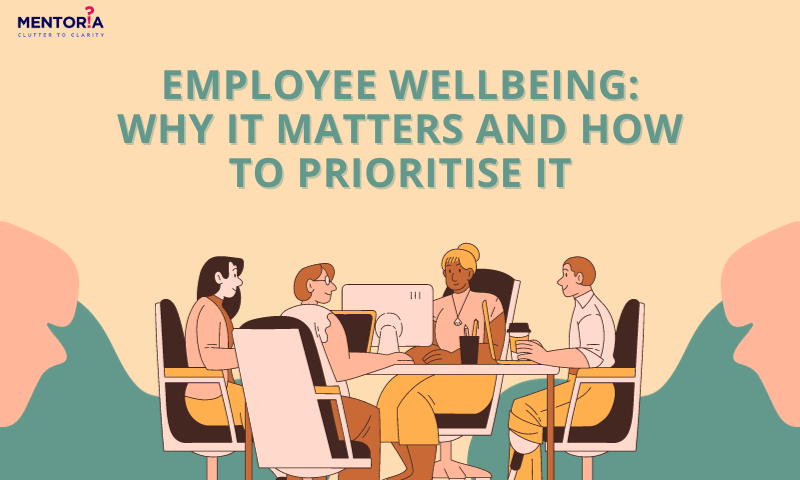Employee Wellbeing: Why it Matters and How to Prioritise It

Let’s talk about something that’s been making a lot of noise in the corporate world, and rightly so: Employee wellbeing. A wellbeing survey that Mentoria conducted across hundreds of corporations revealed that 53% of their employees in the 30-49 age-group, that is actually the most productive workforce for any company, was disengaged. Though companies today offer various perks, such as flexible work hours, health insurance, and wellness programmes to enhance the overall wellbeing of their employees, however, it’s evident that beneath the surface, a significant number of employees still face job burnout and stress.
In this article, we will delve into the importance of employee wellbeing and explore ways to prioritise it effectively.
Importance of Employee Wellbeing
Employee wellbeing encompasses the mental and physical health of employees, influenced by numerous factors, both within and outside the workplace. This holistic approach considers various aspects, including relationships with colleagues, access to resources, and the impact of business decisions. Prioritising employee wellbeing yields several benefits:
Enhanced Productivity: Well-cared-for employees tend to make better decisions and exhibit healthier behaviours, resulting in increased productivity.
Elevated Morale: Meeting employees’ physical, mental, and financial needs fosters a sense of competence and value, leading to higher morale.
Attracting Top Talent: Companies that value work-life balance and employee wellbeing are more likely to attract and retain skilled candidates.
Positive Customer Relations: Happy employees often become enthusiastic brand ambassadors, leading to improved customer relations.
Challenges in Prioritising Wellbeing
Despite the availability of benefits and wellness programmes, employees can still experience stress at work. To effectively prioritise wellbeing, it’s essential to understand the obstacles that employees face. Some of these challenges are:
Leadership Style: Poor management practices, such as micromanagement, can significantly increase employee stress, leading to feelings of incompetence and frustration.
Workload: Heavy workloads, often due to understaffing or urgent business needs, can result in stress, reduced work quality, and feelings of helplessness and fatigue.
Reduced Social Support: A supportive work environment that values effective collaboration is crucial for employee wellbeing. Competitive atmospheres and constant performance comparisons can lead to self-esteem issues and toxic work relationships.
Task Clarity: Clear guidance and training are vital for employees to prioritise tasks effectively. Without clarity, employees may feel confused and struggle to set smart goals.
Motivation: Enjoyable work experiences and a sense of pride in one’s work are essential for maintaining motivation. Mundane, uninspiring tasks and routines can lead to reduced motivation.
Prioritising Employee Wellbeing for a Thriving Workplace
In today’s dynamic corporate world, prioritising employee wellbeing has evolved from a mere trend into a fundamental necessity for organisations. While various perks and wellness programmes are essential, it takes a comprehensive approach to truly enhance employee wellbeing. Let’s explore these six highly practical strategies to prioritise employee wellbeing.
-
Effective Communication
Effective communication is the cornerstone of a wellbeing strategy. Implementing regular pulse surveys with anonymous responses can gauge employee sentiment and pinpoint areas that need improvement. Here’s how you can do it:
Utilise Pulse Surveys:Conduct regular surveys using 360 degree feedback software to gather feedback on various aspects of employee wellbeing.
Personalised Support: Tailor your wellbeing strategy based on survey responses.
Ensure Anonymity: Guarantee anonymity in surveys to safeguard the interest of the employees so they can express their concerns and ideas freely.
-
Give Recognition
Employee recognition is a powerful tool for enhancing wellbeing. It fosters a sense of value and belonging among employees. Consider the following approaches for the same:
Celebrate Milestones: Acknowledge employee milestones such as work anniversaries and birthdays.
Encourage Positive Interaction: Create an environment where employees can comment on each other’s achievements, promoting positivity and a sense of community.
-
Introduce Flexible Work Options
Flexible working arrangements can significantly contribute to employee wellbeing. Here are some of the ways you can implement this:
Flexible Schedules: Allow employees to work around their office hours to accommodate their own schedules better. The option of work-from-home or remote jobs can be a blessing for several of them.
Encourage Breaks: Promote regular breaks to prevent burnout and improve work-life balance.
-
Encourage Personal Development
Personal growth is a crucial element of employee wellbeing. Encourage continuous learning and self-improvement through the following techniques:
Ongoing Training: Provide opportunities for employees to develop new skills and expand their knowledge.
Support for Growth: HR professionals can play a vital role in inspiring personal growth and offering support through specific employee-centric policies to people who, let’s say, have taken a sabbatical or were on maternity leave.
-
Boost Team Relationships
Positive working relationships are essential for employee happiness. Strengthen team dynamics through team-building activities and social interactions:
Team Building: Organise activities like fun games once a week to bring teams closer and promote collaboration.
Inclusive Atmosphere: Ensure that every team member has a voice and the opportunity to interact beyond the confines of their roles.
-
Encourage Social Interaction
Social interaction is crucial for fostering a sense of belonging and community among employees. Create spaces and opportunities for employees to connect:
Social Spaces: Designate areas where employees can socialise and share their experiences.
Online Platforms: Utilise social tools like Slack or Discord to encourage employee connections and interactions.
How Mentoria Can Help
To sum it all up, prioritising employee wellbeing is not a one-size-fits-all approach but a comprehensive strategy that involves effective communication, recognition, flexibility, personal growth, strong team relationships, and social interaction. By addressing these aspects, organisations can create a workplace where employees thrive, resulting in higher morale, improved wellbeing, and increased retention. Mentoria has partnered with several organisations with an aim to encourage and incorporate employee wellness regimes, so every employee is valued not just for work, but also retention. Remember, a workplace that genuinely cares for its employees will receive their dedication and loyalty in return. And that ultimately leads to a more successful and productive organisation.









